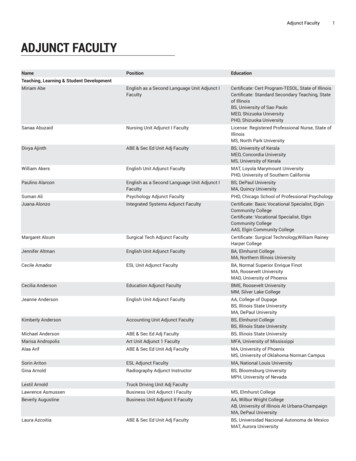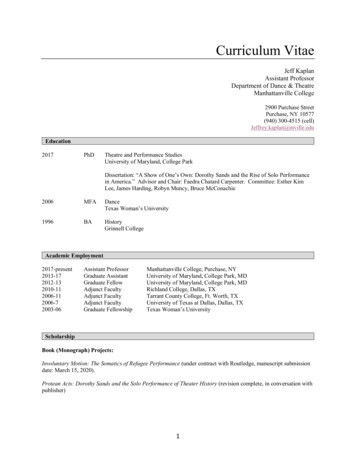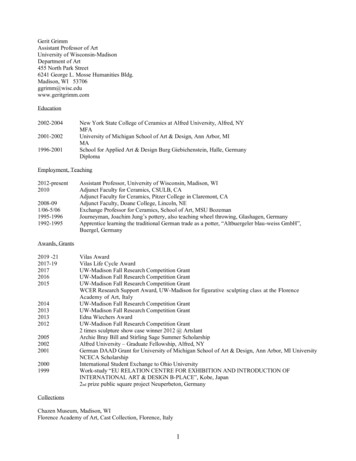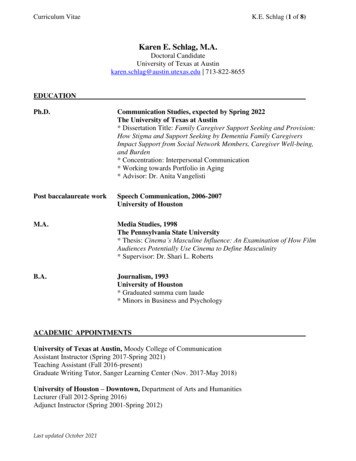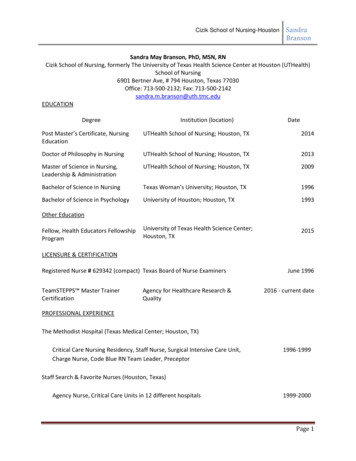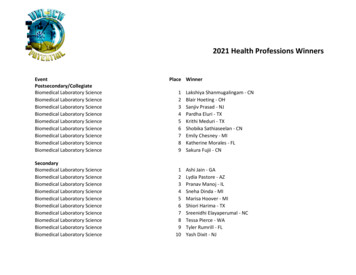
Transcription
International Journal of Social Science And Human ResearchISSN(print): 2644-0679, ISSN(online): 2644-0695Volume 04 Issue 04 April 2021DOI: 10.47191/ijsshr/v4-i4-02, Impact factor-5.586Page No : 571-579Clinical Adjunct Nursing Faculty Virtual Mentoring Experience:A Qualitative StudyJennifer Reyes1, Lori Kupczynski 2, Angela Gibson3, Sunddip Panesar-Aguilar41Hillsborough College, FLUniveristy of St. Augustine for Health Sciences, St. Augustine, FL2,3,4ABSTRACT: Nursing and nursing education have been surrounded by discussions of shortages for many years. The United Stateslacks qualified nurses to care for its aging and increasing acutely ill population. The lack of qualified nurses stems back to severalissues, at the forefront, a lack of qualified nurse educators. Due to the demand for skilled and competent nursing faculty, schools ofnursing have been utilizing bedside nurses to teach in the clinical setting. While many are experienced bedside nurses, they may notbe formally prepared to teach students. Clinical adjunct nursing faculty are also unique because they may never step foot on a collegeor school of nursing campus, teaching exclusively at the clinical site. This can lead to feelings of stress and lack of support from theother faculty members. It may also make it difficult to help prepare and guide clinical adjunct faculty as they teach and encountereducational issues without proper training. Mentoring is routinely cited as valuable to new faculty transitioning to the educationrole. The purpose of this study was to explore a new trend in mentoring, virtual mentoring, and determine if it is of value to clinicaladjunct nursing faculty. Guided by a basic qualitative research design, eleven clinical adjunct faculty who have experienced virtualmentoring were interviewed in order to gather their perspective of the process and formulate interventions that may enhance thevirtual mentoring process for this faculty population.KEYWORDS: Nursing education, nursing, mentoring, clinical adjunct nursing, virtual mentoring, higher education.I. INTRODUCTIONThe United States (U.S.) is facing a nursing shortage while concurrently pushing to advance the education level of its nursingworkforce. The profession has been facing such a shortage for decades. The American Association of Colleges of Nursing (AACN)and the Bureau of Labor Statistics recently suggested that a 15% increase in Registered Nurses (RN) is needed to care for thegrowing population1.As means to combat the nursing faculty shortage are discovered and discussed, institutions continue to hire expert clinicians to filladjunct nursing positions2. Nursing faculty who hold bachelor’s and master’s degrees in nursing or advance practice nursing arebeing recruited from the clinical setting to teach students in the clinical setting due to their expertise. Often, clinical instructors inthis position lack formal training in educational principles3. Due to the nature of the role, many clinical adjunct faculty membersteach off-campus and find themselves lacking support from other instructors and seasoned faculty4. Additionally, many clinicaladjuncts have not received formal education in teaching and learning strategies to support student needs 2.A study by Roberts, Kasal-Chrisman, and Flowers5 suggests that adjunct faculty who are immersed in a robust orientation andmentoring experience are more likely to feel supported and empowered to handle student issues. This, in turn, can lead to a greaterincrease in job satisfaction and job stability5. While a robust mentoring experience seems to be the answer to some faculty issues,challenges persist around what the framework and expectations of mentoring experiences should be. A study conducted by Swanson,Marson, and Malone6 indicated that expectations must be similar among faculty mentors, mentees, and the institution itself;otherwise, differing expectations can eventually lead to faculty mentees seeking other means of employment.In nursing education, especially when expert nurses transition to novice nurse educators, mentoring may ameliorate the nursingfaculty shortage by increasing feelings of support and job satisfaction and decreasing turnover 7. It is also believed that mentorshipin nursing education can help build leadership skills and reduce the number of educators who eventually leave the profession7. Asnurse educators enter the world of academia, it is believed that mentorships are valuable in helping them gain confidence andcompetence while also influencing their teaching styles2.One form of mentoring is known as “virtual mentoring,” and refers to the teaming of a novice nurse educator with an experiencednursing educator via some type of virtual communication8, i.e. email, Skype, or video phone call. Research related to both virtualmentoring and mentoring of adjunct faculty members in nursing education is limited 9. Given the positive impact of mentoring,7IJSSHR, Volume 04 Issue 04 April 2021www.ijsshr.inPage 571
Clinical Adjunct Nursing Faculty Virtual Mentoring Experience: A Qualitative Studymore mentoring experiences should exist for all nursing faculty. The use of virtual mentoring can allow for more specific mentoringfor clinical adjunct faculty nurse educators, helping them develop teaching and learning strategies and navigate the educationenvironment, and become stronger educators8.II. RESEARCH PROBLEMThe problem was clinical adjunct faculty perceptions of virtual mentoring. The use of virtual mentoring may be a solution toproviding a mentoring experience for clinical adjunct faculty who would benefit from mentoring but do not hold a traditionalacademic role. However, the perceptions of virtual mentoring from those clinical adjunct faculty who have experienced it areunknown.The purpose of this basic qualitative study was to explore clinical adjunct faculty’s perceptions and views of virtualmentoring. Understanding these experiences, as described by the clinical adjunct faculty, may provide valuable insight to communitycolleges with nursing programs, as well as other colleges and universities, about virtual mentoring strategies that would enhancejob satisfaction and possibly lead to longer tenures at one institution. By taking into account the experiences of adjunct clinicalnursing faculty who have participated in a virtual mentoring program, colleges of nursing can develop a cost-effective method toeducate and engage their clinical adjunct faculty while increasing faculty retention rates and job satisfaction, as well as promotingan engaging culture, and helping clinical adjunct faculty form a teaching identity.III. LITERATURE REVIEWTheoretical/Conceptual FrameworkSchoening10 developed the Nurse Educator Transition Theory (NET) Model to describe the transition from clinical practicenurse to a nursing educator. Schoening10 classified the phases during the transition period and concluded negative effects that canoccur but may also be reduced through mentoring during this timeframe. Schoening10 described four phases that RNs experiencewhen transitioning to nurse education. These four phases are: (1) anticipation/expectation, (2) disorientation, (3) informationseeking, and (4) identity formation6. Each stage is considered an integral part of the nursing faculty’s development.According to Schoening6, the NET model begins with the anticipation/expectation phase during which involves decidingto become a nurse educator and leave the current role at the bedside. During this phase, after the initial decision to transition toacademia, research about nursing education leads to the discovery of other benefits, such as predictable scheduling, holidays andweekends off, etc., further fueling the desire to teach6. Research does not provide the RN with details about the teacher-studentrelationship or even expectations of their new role; therefore, during the second phase, when the RN begins working as a nurseeducator, a period of disorientation occurs6. Schoening6 stated that disorientation occurs due to a lack of structure, expectations,mentorship, and socialization. Schoening11 characterized this feeling as a downward movement as the expert RN now becomes anovice nurse educator, further fueling the disorientation experienced.Due to the disorientation experienced by the nurse educator, the third phase of Schoening’s model is the most critical.During the information-seeking phase, the nurse educator will seek information, mentorship, and understanding of the new role 6.The opportunity to introduce efficient and effective mentoring is presented in this phase and should be provided to the new nurseeducator. A lack of structure, expectation, and socialization can deter the new nurse educator away from the role. While attemptingto fact find during the information-seeking phase, Schoening6 stated that novice nurse educators may “over prep,” driven by a fearof failure. Structured orientations, faculty development opportunities, and mentoring should be incorporated into the nurseeducator’s transition to reduce the fear of failure and possibly the disorientation phase entirely6.Following the information-seeking phase, the information formation phase will occur. This phase builds off the informationprovided during the third phase and the new nurse educator will start to blend their nursing knowledge with their educator knowledgeand experience to form a new identity6. The faculty member will establish boundaries, find their teaching style and philosophy, andmay take on additional responsibilities or roles6.Schoening’s model10 serves as an excellent framework for the clinical adjunct faculty experience. When evaluating clinicaladjunct faculty perceptions of virtual mentoring, it should be compared to the NET model to help determine if virtual mentoring iseffective and allows for a reduction of the disorientation phase. A reduction or elimination of this phase, according to Schoening 6can have a positive impact on socialization to the profession, experiences with and for students, and feelings of confidence.The Role of the Adjunct Nursing FacultyAdjunct faculty are not exclusive to nursing education. The role of the adjunct faculty member is to support institutionalor full-time faculty member teaching needs as well as student support roles11. Adjunct faculty may work part-time or on an asneeded basis for the institution while their main job exists outside the institution4. These faculty positions are often viewed as costeffective and flexible allowing administrators to meet the changing influx demands of students 12.IJSSHR, Volume 04 Issue 04 April 2021www.ijsshr.inPage 572
Clinical Adjunct Nursing Faculty Virtual Mentoring Experience: A Qualitative StudyThe Role of the Clinical Adjunct FacultyClinical adjunct faculty may be specific to health science programs. These faculty members' primary responsibility isteaching and learning of clinical concepts to students and supervising their performance within the clinical setting4. Oftentimes innursing education, adjunct faculty are utilized in the clinical setting to extend the knowledge gained in the classroom as well as meetaccreditation standards for accompanying clinical requirements. There are benefits as well as disadvantages to utilizing adjunctfaculty in this way. To use adjunct faculty in the clinical setting means that clinically experienced and competent practitioners mustbe hired10,11. Utilizing competent or expert clinicians aids in student’s learning and understanding; however, many times theseclinicians are not adequately trained in the principles of teaching and learning and do not possess the skill set required for academia6.The nature of the clinical adjunct faculty role leads to faculty members teaching off-campus and finding themselves lackingsupport and socialization from other instructors and seasoned faculty4,6. This can be a source of stress for clinical adjunct facultywhile they are decreasing stress for the full-time faculty members they are supporting12. Many first-time clinical educatorstransitioning from the bedside cite lack of information related to how to teach and lack of communication from full-time facultymembers as obstacles they face13.Transitioning ExperienceThe lived experiences of clinicians transitioning to teaching have been documented within nursing as well as otherhealthcare disciplines. Nurses who transition from the bedside to academia often find ambiguity surrounding their new role andexpectations, however, faculty mentoring, and guidance is helpful to reduce ambiguity12. Locasto and Kochanek14 utilized the theoryof “reality shock” to describe how clinicians’ transition to academia and evolve based on interactions and acceptance of the“challenges as part of the position” (p. 81). Upon entering the world of academia from clinical practice, novice nurse educators aremet with the new workload and tenure-track demands in addition to a lack of support or guidance from senior faculty15.Job Dissatisfaction. Locatso and Kochane14 reviewed several aspects of the nursing academia world that may shock,overwhelm, and dissatisfy the novice nurse educator. It is during the nurse educator’s transition that the authors indicated they willprogress through four stages referred to as moral outrage, rejection, fatigue, and perceptual distortion. During these stages, the neweducator runs the risk of “becoming a doer rather than a teacher” 14 (p. 80). The authors stated that the new nurse educator, withoutthe right training and guidance, may become overwhelmed, take too much work home, and eventually long to return to the bedside14.Compensation and Benefits. Barriers in nursing educator transition include perceptions of the educator role, the workenvironment, increased difficulty, increased job responsibility pressure, and compensation 16. The National League for Nursing(NLN) also found that inadequate wages put a strain on faculty and influence them to stay in or return to clinical practice17. Nurseseducators’ salaries are remarkably less than faculty in other disciplines in higher education17. Additionally, in the same report bythe NLN, nurse educators’ salaries in the United States are similar to RNs working at the bedside and less than other advancedpractice degree nurses (ARNPs, nurse midwives, CRNAs).While compensation is not as easy to remedy as other barriers, it can influence clinical adjunct faculty to stay in the position.A majority of clinical adjunct faculty hold employment outside of their teaching job11. This is often due to the pay difference fromworking at the bedside. Clinical adjunct faculty holding additional employment outside of teaching, are more likely to experiencework imbalance and stress over juggling multiple jobs and therefore have less job satisfaction11. Faculty retention could be increasedthrough socialization and support11.Feeling Unprepared. As nurses seek to fulfill their desire to teach future nurses, research indicates that many feltunprepared to handle their new role as clinical adjunct faculty and that preparing for their role as a clinical instructor was anenormous undertaking18. Clinical adjunct faculty reported feeling unsure of the institution’s expectations of them and experiencedfeelings of isolation3,18. These feelings are referred to in Schoening’s disorientation phase of the Nurse Educator Transition Theory10.During this phase, Schoening10 noted that this feeling occurs due to a lack of structure and mentorship. Additionally, other literaturealso supports the use of mentoring to reduce these feelings which, if unrecognize can increase job dissatisfaction and lead to turnover.MentoringFormal Faculty Mentoring. The value of mentoring is well established throughout the literature related to nursing andnursing education as well as other healthcare disciplines7,18. Yet, many adjunct faculties in nursing education report that they werenot properly mentored or did not receive any mentoring at all19. The literature review included an assessment of current mentoringpractices used throughout nursing education as well as in nursing and education. Throughout the review, researchers found thatmentoring has a positive impact on job satisfaction, recruitment, and retention of nursing faculty20. Despite the numerous benefitsof mentoring discussed, there no consistent mentoring framework 7.Barriers can also exist with mentoring and for many there can be disconnects between the mentor and mentee personalities,experience, and teaching style. The mentoring experience is only effective if the mentor is committed and passionate aboutmentoring. The mentor and mentee relationship must be a good fit for both parties. Characteristics of a good mentor should includeconfidence, possession of active listening, and communication skills. Additionally, good mentors should be motivating,IJSSHR, Volume 04 Issue 04 April 2021www.ijsshr.inPage 573
Clinical Adjunct Nursing Faculty Virtual Mentoring Experience: A Qualitative Studyknowledgeable, and have a positive attitude21. There is also an investment of time, effort, and caring on both parties’ part, to achievea successful mentoring relationship/experience21.Virtual Mentoring. Virtual mentoring was defined as the use of technology to host professional connections8. Due to thenature of this definition, other names can include e-mentoring, telemonitoring, online mentoring. Virtual mentoring is beneficial foradjunct faculty8. There are many platforms and ways for a mentor and mentee to engage, allowing for flexible meeting times,individualized guidance, and emotional support 8. Similar to themes identified when exploring faculty mentoring, there is a lack ofstructure for virtual mentoring in nursing education as it is a relatively new concept 8.IV. METHODOLOGYA qualitative methodology was used to explore the perceptions of clinical adjunct faculty’s experience with virtual mentoring andits value. The use of this methodology best suited this study since perceptions were needed to determine the value of virtualmentoring. Additionally, virtual mentoring is a newer phenomenon in nursing education, therefore, a qualitative methodology washelpful to the researcher to gain an in-depth understanding of how clinical adjunct faculty perceived their experiences with virtualmentoring and the implication of it.VI. DATA ANALYSISA. Population and SampleThis study relied on voluntary participants who meet the inclusion criteria. The college selected for this study was a largepublic college located in the state of Florida. Full-time and clinical adjunct faculty are responsible for the didactic and clinicaleducation the students receive. The population of nursing faculty at the college includes 37 clinical adjunct faculty that support thefull-time faculty and students. Clinical adjunct faculty are assigned to the clinical areas to fulfill expected student-to-instructor ratiosduring clinical experiences and ensure successful clinical experiences for students and patients while practicing in the inst itution.The clinical adjunct faculty members employed by the college are required to work with students in a variety of healthcaresettings. Clinical adjunct faculty members attend clinical with students throughout the metropolitan area within five differenthospital systems with a combined total of 14 hospitals. Typically, clinical adjunct faculty work in this role 8-10 hours a week forthe duration of the assignment. Many also lead clinical experiences in the same hospital where they concurrently practice as aRegistered Nurse leading to differences in experiences for students.The sample of this study included new clinical adjunct faculty hired within the 2019-2020 school year and who haveexperienced virtual mentoring efforts. These clinical adjunct faculty were exposed to new virtual mentoring efforts instituted by thenursing program that is a part of the community college. The sample was comprised of clinical adjunct faculty members with 3years or less of nursing education experience and 10 or more years of nursing clinical practice experience.B. InstrumentationFor this study, basic demographic information was gathered at the beginning of the interview, followed by open-endedquestions related to the virtual mentoring experience in its entirety. Specific interview open-ended questions followed related to therequired asynchronous course provided to the clinical adjunct faculty upon hire, the synchronous check-ins with a lead facultymember which was guided by a mentoring checklist, and the weekly topical emails known as Monday Morning Mentor. Theparticipants then were asked to express any final thoughts that they wished to communicate.C. Data CollectionUpon hire, new clinical adjunct faculty were asked to participate in a one-time asynchronous course offered by theinstitution. During the virtual mentoring process, a checklist was used to ensure specific top ics related to institutional policiesand procedures, academic standards, etc., were being met as well as ensure discussion of experiences the clinical adjunct fac ultymay have while in the hospital setting. Clinical adjunct faculty perceptions of this too l could indicate if it was useful in guidingthe mentoring meetings or if it was a barrier. Clinical adjunct faculty and full-time faculty received weekly topical emails toprovide knowledge and support while in the clinical setting. Clinical adjunct faculty perceptions of these emails could indicateif this was a useful way of guiding the semester.Data PreparationEleven clinical adjunct faculty voluntarily participated to be interviewed. The participants' information was numericallylabeled for data collection and analysis and to maintain privacy and confidentiality. Due to social distancing restrictions placed atthe data collection site, participants were interviewed virtually. No audio or visual recording took place, and data was transcribedimmediately verbatim as the participants provided their responses. Most interviews lasted between 45-55 minutes.VI. ANALYSIS AND RESULTSDescriptive StatisticsThe demographic characteristics of the sample revealed that 10 participants were female and two participants were male, twoparticipants were between the ages of 26-35, six participants between ages 36-46, and three participants between the ages of 47-57.IJSSHR, Volume 04 Issue 04 April 2021www.ijsshr.inPage 574
Clinical Adjunct Nursing Faculty Virtual Mentoring Experience: A Qualitative StudySeven participants had a master’s degree, four participants held bachelor’s degrees, and two participants disclosed second master’sdegrees outside of nursing education. All participants maintained regular employment in addition to their clinical adjunctfaculty role, with 10 working full time and one employed part-time. There was an average of 12 years of nursing experience and 3.5years of nursing education experience among participants. Demographic data are listed in the table below (Table 1).Table 1. Table of Demographic Data of Participants of the StudyParticipant1 2 34567 89 10 11Age48 44 35 47 43 41 33 38 36 46 52GenderFFFFM M F FF FFRaceCCCCCH C CC HCNursingexperience (Yrs.)25 11 14 976Nursing education experience (Yrs.)4.5 130.5 1 2Highest degree levelMSN/EDYWorks elsewhere145 10 14 15 302 6MS BS MS MS BS BS MS BS MSN/E N N/E N/E N N N/E N N/EDD DDDY Y Y Y Y Y Y Y Y18MSN/EDYVII. RESULTSThe major themes identified were Collaborate, Effective Communication, Meaningful Interactions, Socialization to the Role,Valuable, and Teach (Table 2).Table 2. Themes and ParticipantsThemeCollaborateMeaningful InteractionsSocialization to the RoleEffective CommunicationValuableTeachParticipant #1, 2, 3, 4, 5, 6, 7, 8, 9, 10, 111, 2, 5, 6, 7, 8, 9, 10, 111, 2, 3, 4, 5, 6, 7, 8, 9, 112, 3, 4, 5, 6, 8, 10, 114, 5, 6, 7, 8, 9, 10, 111, 3, 4, 7, 9, 10, 11Research Question 2: What are mentees' experiences with virtual mentoring?The first research question was developed to explore with participants the virtual mentoring they received to prepare themand support them for teaching in the clinical area. The interview questions were designed to elicit participants’ descriptions relatedto their experiences throughout the program. Responses were extracted related to how the participants were prepared for their newrole at the data collection site as well as if particular aspects of the experience, such as synchronous meetings, an asynchronouscourse, a mentoring checklist, and weekly email tips, helped to promote a positive experience.Participants were asked if the specific activities within the virtual mentoring program were valuable, what did not work,what they perceived as missing from the experience, and how effective they felt the virtual mentoring experience was at helpingthem transition to the clinical adjunct faculty role at the institution. All 11 participants addressed these questions and multiplethemes emerged. Many participant responses centered around opportunities to collaborate with their mentor and prepare for theirclinical experiences, discussing roles and expectations and teaching strategies with their mentor, and having multiple clinicalteaching articles and ideas at their fingertips.As the analysis of participants’ responses took place, the theme of collaborate was established when participants spokeabout working with their mentor on strategies, plans, or any part of their performance. The theme of meaningful interactions wasestablished when participants spoke about how they felt when meeting or communicating throughout the virtual mentoringprogram.Theme 1: CollaborateThe theme collaborate was first recognized in multiple interview responses related to research question one. Participantsdescribed how working with lead faculty members and within the other components of the virtual mentoring program helped tofurther define the role of the clinical adjunct faculty member and to provide insight and strategies when teaching in the clinicalIJSSHR, Volume 04 Issue 04 April 2021www.ijsshr.inPage 575
Clinical Adjunct Nursing Faculty Virtual Mentoring Experience: A Qualitative Studysetting. Several participants described how the virtual mentoring program afforded them the opportunities to collaborate with theirmentor about specific elements of their job or expectations. The communication, if mentioned by participants, was described as“valuable” or “helpful”. Some also mentioned developing strategies, during those meetings, to use while out in the clinical areathanks to the program. One participant stated, “I liked having my mentor and those online pieces that I could work at my own paceand go back and forth when I needed to prepare, plan, or needed an idea for clinical.” Another participant stated, “I think it [virtualmentoring] was effective. I was mentored via zoom and able to meet with my mentor and discuss different components of what isexpected of me, but she also talked to me about how to do it.” The key from this participant’s response was that the mentor helpedher with how to do a component of her role. It is implied that the participant was not just given a folder full of instructions and a jobdescription, but instead strategies and guidance for how to effectively perform in the role of clinical adjunct faculty. The participantlater stated the mentor collaborated with her and “sent resources I could use in clinical” that she used to prepare alternativeplans for clinical (a module within the asynchronous course) “I used the back-up plan discussion to start thinking about what Ishould do and I was able to keep some clinical questions with me and I started having students do some NCLEX style quizzes duringpost-conference.”Theme 2: Meaningful InteractionsThe theme of meaningful interactions also emerged after analyzing the data. This theme was identified when participantsdescribed the types of communication and experiences they had with their mentor and the other components of the virtual mentoringprogram. The theme of meaningful interactions was established when participants spoke about how they felt when meeting orcommunicating throughout the virtual mentoring program. Typically, this theme emerged when codes such as “supported”,“valued”, “open communication”, or “teamwork” were identified in the participant’s responses.Six participants described correspondence that occurred between themselves and the lead faculty that were valuable andmeaningful to their role and how they felt towards the role. One participant commented, “When my mentor said ‘It’s ok to call meand text me’ that provided reassurance that it was more than just one time. It was a follow-up and follow-through.” The virtualmentoring program may have prompted specific interactions between mentor and mentee, but the specification of meaningfulinteractions comes from the idea that the clinical adjunct faculty member felt supported and valued in the role, despite not workingin the same physical location as the full-time faculty members.A second participant stated “it was nice that someone took the time to check-in with me and that the focus could be aboutanything, not just student issues/concerns. I felt supported and that someone was listening to me.” Clinical adjunct faculty maysometimes feel that their only communication with lead faculty or classroom instructors is when there is a student or safety issue.Having scheduled virtual opportunities to check-in with the clinical adjunct faculty member may help improve overall satisfactionin their role.Research Question 2: What do mentees perceive as the successful aspects of virtual mentoring?The second research question was designed to dissect what participants found most successful during their virtualmentoring experience. The interview questions were designed to elicit participants’ descriptions of those activities, strategies, and/orinformation that helped prepare them most while preparing for their clinical adjunct faculty role and assisted thei
Clinical adjunct nursing faculty are also unique because they may never step foot on a college or school of nursing campus, teaching exclusively at the clinical site. . may provide valuable insight to community colleges with nursing programs, as well as other colleges and universities, about virtual mentoring strategies that would enhance .
